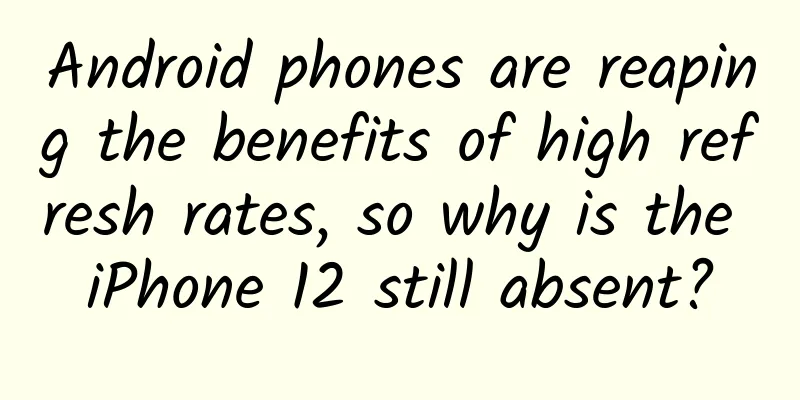Android phones are reaping the benefits of high refresh rates, so why is the iPhone 12 still absent?

|
Recently, there have been more and more revelations about the iPhone 12, and even the release price has been on the top of the Weibo hot search list, but there are still different opinions about the screen refresh rate of the new iPhone. According to current predictions, the best case scenario is that the high refresh rate may only appear on the highest version of the iPhone 12, and the basic version responsible for sales may not have a high refresh rate.
Battery shrinkage and increased power consumption make high refresh rate a problem for iPhone 12 Even though Apple does not proactively disclose the specific battery capacity every year, based on subsequent hardware information, we can still deduce the battery capacity of the iPhone 11 series: the battery capacity of iPhone 11 is 3110mAh, the battery capacity of iPhone 11Pro is 3046mAh, and the battery capacity of iPhone 11Pro Max is 3969mAh. The corresponding sizes are 6.1 inches, 5.8 inches, and 6.5 inches respectively. The previous generation of iPhones greatly changed the public's impression of it with its good battery life performance, but to some extent, the absence of 5G modules and the cancellation of 3D Touch components have exchanged more internal space for the battery of the iPhone 11 series. In other words, the battery life of the iPhone is still inseparable from the battery hardware configuration (even though the background management and battery life optimization of iOS are already excellent enough). According to the battery capacity of the iPhone 12 series, the battery capacities of the four sizes of the new iPhone are: 2227mAh, 2775mAh, and 3687mAh, corresponding to iPhone 12 (5.4 inches), iPhone 12 Max, iPhone 12 Pro (6.1 inches), and iPhone 12 Pro Max (6.7 inches). By comparing the two, it is easy to find that the 5G baseband and related components occupy more space inside the iPhone 12 series, and the power consumption of the new iPhone has decreased. Perhaps this move is to reduce the cost of 5G upgrades, but in fact it is equivalent to announcing the hopelessness of high refresh rates. After all, with a battery capacity of 2,000 mAh, no matter how magical the background management is, it cannot turn decay into magic. According to the test conducted by foreign technology media Anand Tech on the Samsung S20+ series, when connected to WiFi and browsing the web at 120Hz/60Hz refresh rates, the Samsung S20+ can be used for 11.1 hours at 60Hz, but only 8.85 hours at 120Hz. The conclusion is that the screen time at 120Hz is 3 hours less than that at 60Hz. The impact of high refresh rate on power consumption cannot be underestimated. Even with optimistic speculation, we can only hope that the highest-spec iPhones can support high refresh rates. On the one hand, Apple's A14 Bionic chip will use TSMC's 5nm process. According to TSMC's official publicity figures, the transistor density under TSMC's 5nm process has increased by 84% (from 91.2 million per square millimeter in the first generation 7nm to 171.3 million per square millimeter). While the transistor density has been greatly improved, compared with the 7nm process, the power consumption of the 5nm process is reduced by 30% under the same performance, and the performance is improved by 15% under the same power consumption. The power consumption performance ratio is one of the few hopes for the iPhone. On the other hand, according to the leaked screenshots, a screenshot of the refresh rate limit appeared in the iPhone's system interface, and users can adjust the refresh rate to 60Hz. Many people regard this as evidence that the iPhone supports high refresh rates. After all, only when the refresh rate exceeds 60Hz is it necessary to limit it downward. Referring to the ProMotion adaptive refresh rate technology used by Apple on the iPad Pro (which supports a 120Hz refresh rate), the screen will automatically increase the refresh rate to 120Hz when needed, which may reduce the power consumption caused by high refresh rates. For users who are looking forward to the new iPhone, the battery capacity of the basic iPhone has been reduced, and under the dual influence of 5G and high refresh rate, the hope of having a high refresh rate is slim. At the same time, for high-spec iPhones, the evidence of their support for high refresh rate is not clear and strong enough. Maybe we should be prepared for the absence of high refresh rate in the iPhone 12 series. High refresh rate is crucial for Android phones, so why does Apple have an exemption? The absence of high refresh rate is totally unimaginable in today's Android camp. The first wave of manufacturers that started the high refresh rate trend are still enjoying the benefits of high refresh rate: OnePlus is still one of the brands with the best high refresh rate experience. Starting from the optimization of 90Hz refresh rate, it has focused on the overall UI dynamic effect, which has also prompted many users to come into contact with this brand that focuses on screen experience. However, a few Android models still remain at 60Hz, which makes them an outlier in the overall high refresh rate Android camp. The absence of high refresh rate has become a shortcoming in their competitiveness. With the popularity of high refresh rates, screens with refresh rates of 90Hz, 120Hz and even 144Hz have appeared one after another. Even though the Android camp still needs to improve its adaptation in terms of game content and global frame rate stability, it is clear that Android has already built an ecosystem for high refresh rate experience. This is not good news for iOS, which is famous for its smoothness. Although sensitivity to high refresh screens varies from person to person, the Android user experience at 90Hz and 120Hz is much smoother than the iPhone's 60Hz screen, even though the latter has profound capabilities in aspects such as non-linear animation and interactive response. The problem is that even if the iPhone 12 series does not have a high refresh rate screen, there will still be many users who will pay for it, just like what happened to the iPhone SE, a small-screen 4G mobile phone with a single camera, non-full screen, and small battery, as 5G became popular. The reason is that the advantages of the iPhone are as obvious as its disadvantages: the performance of the A series processors is far ahead of Android processors, providing the hardware foundation for its long-term smoothness; the closed but high-quality ecosystem of iOS has caused many users to be deeply "kidnapped" by Apple devices. Coupled with the iPhone's good shooting experience and color management, the iPhone is still the favorite of many imaging practitioners. Here are a few details: the updated iOS 14 allows users to set and lock the exposure level of all photos and videos, a wide dynamic range when shooting videos, and stable color management. These features create a solid imaging moat. Even though Android has taken a different approach to imaging quality by stacking hardware, the iPhone still has its unique features in overall use. In general, even without a high refresh rate, the iPhone 12 series will most likely still be the top mobile device, and its overall balanced performance has earned it immunity from the absence of a high refresh rate. In connection with the price of the iPhone 12 series exposed at the beginning, it is reported that the new iPhone includes four models, with a starting price of US$699 and a starting storage space of 128GB. Compared with the iPhone 11, the quantity is increased without increasing the price. In the face of the real fragrance, the high refresh rate may not be so important. Conclusion Even if the iPhone lacks a high refresh rate, it is harmless, which actually reflects the success of Apple's brand building strategy. Brand recognition is not something that can be achieved overnight. Details such as linear motors and automatic brightness and color temperature adjustment that Android manufacturers have begun to emphasize this year have already been matured and replaced for several generations on the iPhone. Combined with its exquisite craftsmanship and overall product strength, the high-end image has achieved good brand recognition, which can make users willing to pay for the new iPhone. And this is also the part that domestic manufacturers need to work hard to catch up. |
<<: Windows 10 can run Android apps directly, but it requires a Samsung phone
>>: Package visibility in Android 11
Recommend
Bilibili’s 2020 marketing plan!
Bilibili (English name: bilibili, referred to as ...
Why did JD Live, which is unconventional, become so popular?
According to official data, the attention of &quo...
Super Fan Pass is online, how to use it? This guide may be the most complete!
On August 23, all Fans Channels were switched to ...
4 cases to teach you how to use TikTok to promote products!
With the disappearance of the Internet traffic di...
What flowers are suitable to send on Valentine's Day? Guide to sending flowers on Chinese Valentine's Day and the meaning of flowers
The traditional Chinese festival Chinese Valentin...
Baidu search CPC/eCPC/oCPC in one article
When promoting, many students often cannot distin...
Introduction to 360 mobile resource advertising promotion display formats!
Mobile resources: six advertising formats to meet...
Did you know? The mobile phone is 46 years old
Remember your first mobile phone? Xiaolingtong? C...
7 essential promotion skills for operators! Did you know?
01 Promotion skills For operations personnel, whe...
2019 Zhihu product operation analysis!
“Q&A community + knowledge payment” How does ...
Big news, Mitchell is diagnosed with COVID-19! Mitchell tested positive for the new coronavirus!
On March 12, Beijing time, according to US media ...
Detailed explanation of common methods of Android audio acquisition
Preface Android Audio Collection There are genera...
What kind of plant is Stephania? Is it true that cephalothin can treat COVID-19?
Recently, Qianjinteng suddenly became popular bec...
Can I apply for a mortgage payment deferral due to the epidemic? How to apply?
Recently, epidemics have occurred in many places i...
3 data analysis tools you must know when playing Douyin: Use them to avoid many detours
To create a profitable Douyin account, in additio...









